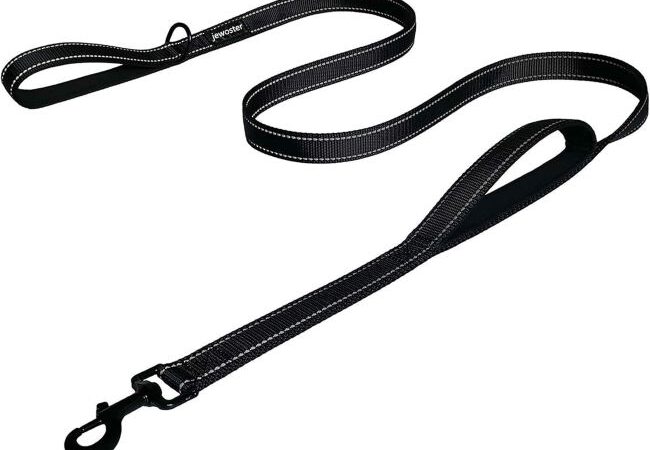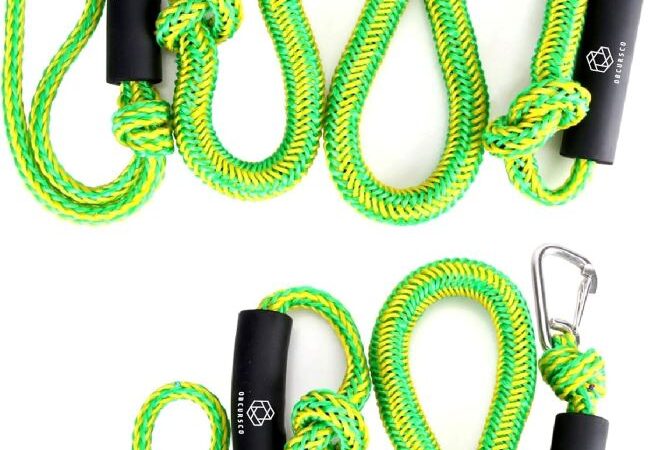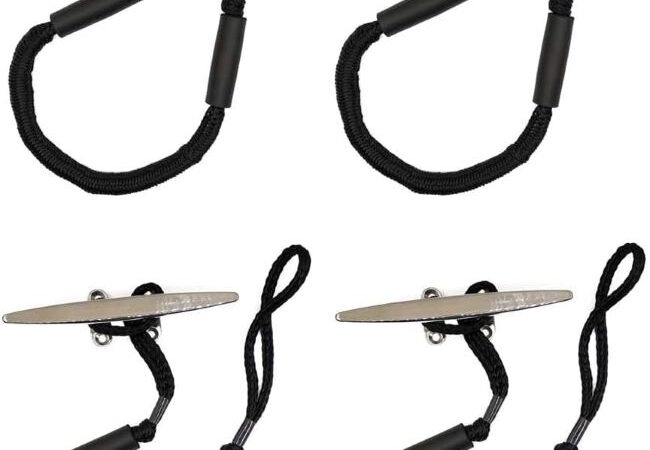How to Tie Guide Ropes: Secure Knots Simplified
To tie guide ropes, secure one end to an anchor point and adjust tension with knots or tensioners. Guide ropes stabilize structures like tents, awnings, and tarps by anchoring them to the ground.
Contents at a Glance
ToggleTying guide ropes correctly is vital for outdoor enthusiasts and campers seeking to ensure their shelters remain taut and secure against the elements. This skill involves selecting the appropriate rope, utilizing reliable knots, and adjusting for optimal tension. Whether you’re pitching a tent, securing an awning, or stabilizing a tarp, mastering the art of tying guide ropes is crucial for both safety and comfort.
Understanding the nuances of knot tying and rope tension can transform a flapping shelter into a steadfast haven. As such, this guide will delve into the essential techniques for tying guide ropes effectively, catering to both novice adventurers and seasoned outdoors people alike.
The Essentials Of Guide Ropes
Whether you’re setting up a tent or securing a tarp, guide ropes are a cornerstone of outdoor stability. Knowing how to choose and tie guide ropes is a skill that enhances safety and efficiency in any outdoor scenario.
Types Of Ropes For Guides
Different outdoor tasks require various types of ropes. Selecting the right type is crucial for the task at hand.
- Nylon ropes: Stretchable and resilient, ideal for dynamic needs.
- Polyester ropes: UV-resistant and durable, great for long-term use.
- Polypropylene ropes: Lightweight and floats on water, suitable for aquatic environments.
Choosing The Right Rope Length
Length is just as important as the type of rope. Too short, and you can’t tie properly; too long, and it’s a tripping hazard.
| Activity | Recommended Length |
|---|---|
| Tent Guy Lines | 6-8 feet |
| Tarp Setup | 8-10 feet |
| Boating | Depends on the boat size |
For most camping scenarios, a standard length of 25 feet is a versatile choice. It allows for adjustment and multiple uses without the excess.
Knots 101: The Basics
Whether you’re pitching a tent or securing a load, the art of tying guide ropes is essential. Knots are the foundation of any good rope setup, and learning them can be a lifesaver. Let’s start with some basic knot knowledge that everyone should master.
Understanding Rope Anatomy
Before diving into knots, recognize the parts of a rope. Ropes have a ‘standing end’, which is the long unused portion. The ‘working end’ is where you tie the knot. The ‘bight’ is a U-shaped bend in the rope, and the ‘loop’ is a circle formed by crossing the rope over itself.
Common Knot Terminology
Here are some terms you’ll hear in the knot-tying world:
- Bend – A knot that joins two ropes together.
- Hitch – A knot that attaches a rope to another object.
- Loop – A full circle made by the rope that remains open.
- Bight – A U-shaped section of rope without crossing ends.
These terms are the building blocks for understanding more complex knots. With practice, these will become second nature.
Preparation Before Tying
Before embarking on your outdoor adventure, it’s crucial to prepare your guide ropes for secure tying. Proper preparation ensures safety and longevity of your ropes. Let’s explore the essentials of rope inspection and care.
Inspecting Rope Condition
First, examine your rope for any signs of wear or damage. Look for fraying, cuts, and discoloration. A compromised rope can fail when you least expect it, turning a calm situation into a dangerous one.
- Check the entire length of the rope.
- Pay close attention to areas that bear more load.
- Replace the rope if you spot significant damage.
Rope Care And Maintenance
Keeping your ropes in top condition is key to ensuring their performance when you need them most. Follow these simple steps for rope maintenance:
- Store ropes in a cool, dry place, away from direct sunlight.
- Avoid contact with sharp objects and chemicals.
- Clean your ropes regularly with mild soap and water.
- Allow them to air dry completely before storage.
Remember, a well-maintained rope is a reliable partner in any outdoor setup.
Starting With Simple Knots
Learning to tie guide ropes starts with mastering some basic knots. These foundational knots serve as building blocks for more complex tying techniques needed in camping, hiking, or even backyard setups. Whether you’re securing a tent, hanging a hammock, or anchoring a tarp, these knots ensure safety and stability. Let’s dive into the essentials of knot-tying.
Tying A Basic Loop Knot
Creating a basic loop knot is the first step in guide rope mastery. This knot is ideal for tasks requiring a quick and secure loop. Follow these steps:
- Take the end of the rope in your hand.
- Form a loop by crossing the end over the standing part of the rope.
- Pass the end through the loop just formed.
- Pull both the end and the standing part to tighten the knot.
This simple loop is quick to tie and essential for everyday use.
Securing A Hitch
To secure a hitch, you’ll need a sturdy anchor point. Hitches are perfect for attaching your rope to a post, tree, or any stable item. Here’s how to tie a basic hitch:
- Wrap the rope around the anchor point.
- Cross the end of the rope under the standing part.
- Bring the end up and through the loop you just created.
- Pull the end to tighten the hitch against the anchor.
This technique ensures your rope stays firmly attached, providing reliability and peace of mind.
Starting with these simple knots will equip you with the necessary skills to handle various outdoor and household tasks. Practice these knots to build a strong foundation for more advanced rope work.
Intermediate Knots For Stability
Mastering the right knots can mean the difference between a secure shelter and a flapping tarp. Intermediate knots offer the stability needed for various outdoor setups. Whether securing a tent or anchoring an awning, these knots ensure your guide ropes hold firm.
The Bowline KnotThe Bowline Knot
The Bowline Knot is a classic choice for its reliability and ease of untying. It forms a fixed loop at the end of a rope, perfect for attaching to stakes or other fixed points.
- Step 1: Make a small loop in the standing part of the rope.
- Step 2: Pass the free end up through the loop.
- Step 3: Wrap the end around the standing part and back down through the loop.
- Step 4: Tighten by pulling the free end while holding the standing part.
The Taut-line Hitch
The Taut-line Hitch is essential for adjustable tension. It is used to tighten or loosen a rope without retying the knot.
- Step 1: Wrap the free end of the rope around the anchor point.
- Step 2: Pass the free end around the standing line, inside the loop, twice.
- Step 3: Make another wrap outside the loops, closer to the free end.
- Step 4: Slide the hitch to adjust tension, and pull tight to lock in place.
Advanced Knot Techniques
Mastering advanced knot techniques is essential for setting up reliable guide ropes. Whether you’re securing a tarp, tent, or awning, these knots ensure stability and strength. Below, we explore two knots that stand out for their gripping power and adjustability.
The Double Fisherman’s Knot
The Double Fisherman’s Knot is renowned for its solid bonding of two rope ends. It’s perfect for creating loops in climbing ropes or extending guy lines. Follow these steps:
- Lay the ends of two ropes parallel to each other.
- Wrap one end around the other rope twice, creating two loops.
- Pass the end back through these loops and pull tight.
- Repeat with the other end on the opposite rope.
- Pull both ends to slide the knots together, forming a strong connection.
This knot’s strength lies in its ability to resist tension from any direction.
The Prusik Knot For Tensioning
The Prusik Knot offers adjustable tension and quick release functionality, making it a top choice for guide ropes. Use it to attach a rope to a rigid line, like when securing tarps. Here’s how:
- Wrap a loop of cord around a main rope several times.
- Pass the end of the loop through its standing part to create wraps.
- Slide the knot along the main rope to adjust tension.
- Pull on the loop to tighten and lock the knot in place.
The Prusik Knot’s beauty is in its simplicity and effectiveness. It grips when weighted and slides easily when not.
Attaching Guide Ropes To Anchors
Securing your shelter with guide ropes is crucial for stability and safety. Proper attachment to various anchors can make all the difference. Let’s learn how to do it right.
Tying Ropes To Stakes
Using stakes is a common method to secure ropes. Follow these steps:
- Choose the right stake. Metal stakes work best for firm soils.
- Drive the stake. Use a hammer to drive it at a 45-degree angle.
- Tie the rope. Use a Bowline knot for secure tying.
The table below shows the best knots for different soil types:
| Soil Type | Knot Type |
|---|---|
| Loose Soil | Double Hitch |
| Firm Soil | Bowline |
Knots For Attaching To Trees
When using trees as anchors, consider these points:
- Avoid damage. Choose trees with thick bark.
- Use a Tree Hugger Strap if available. It protects the tree.
- Select the right knot. A Clove Hitch is effective and easy to untie.
Steps to tie a Clove Hitch:
- Wrap the rope around the tree.
- Cross the end under the standing part.
- Pull tight to secure the knot.
Remember, securing guide ropes properly ensures your setup remains stable and safe in various conditions.
Adjusting And Tensioning Guide Ropes
Proper adjustment and tensioning of guide ropes are crucial for securing tents, tarps, and awnings. The right tension keeps structures stable and resilient against wind and weather. Learn how to use simple tools and methods to achieve the perfect tension.
Using Rope Tensioners
Rope tensioners simplify the process of securing guide ropes. These small devices allow for quick adjustments and maintain tension effectively. Here’s how to use them:
- Slide the tensioner onto your rope before tying it off.
- After anchoring the rope, pull it through the tensioner for a snug fit.
- Lock the rope in place by following the tensioner’s instructions.
Manual Tensioning Methods
When tensioners are not available, you can still manually achieve a taut line. Try these manual tensioning methods:
- Use a taut-line hitch knot, which allows for adjustment after tying.
- Pull the rope firmly and wrap it around the stake in a figure-eight pattern for grip.
- Finish with a secure knot to prevent slipping.
Safety Measures And Best Practices
Ensuring safety and efficiency when tying guide ropes is crucial. Guide ropes secure tents, awnings, and tarps, making them fundamental for outdoor stability. Follow these best practices to prevent accidents and guarantee maximum hold.
Regular Knot Checks
Knot integrity is vital for the safety of your setup. Perform regular checks to ensure knots remain tight and secure. Environmental factors like wind and rain can loosen knots over time.
- Inspect knots daily, especially after severe weather.
- Look for signs of wear or damage in the rope.
- Retighten knots that show any slack to maintain tension.
When To Untie And Retie
Knowing when to untie and retie your knots can prevent failures. Ropes can stretch or shrink, affecting the tension of your setup.
- Untie knots if the rope shows signs of fraying or damage.
- Adjust ropes if your shelter seems to sag or lose shape.
- Retie knots when changing the position or location of the shelter.
Replace ropes that are beyond simple adjustments. Always carry spare ropes for quick replacements.
Creative Uses For Guide Ropes
Guide ropes are not just for keeping tents in place. These versatile tools can shape up your camping experience and come to the rescue in emergencies. Let’s explore some creative ways to use guide ropes outside their usual role.
Improvised Camping Structures
Guide ropes can create innovative shelters and structures. Here’s how:
- Shade awnings: Stretch a tarp over your camping area and use guide ropes to secure it. This creates a cool area to relax.
- Hammock supports: Tie guide ropes between trees and hook up a hammock. You get a comfy spot to sleep or chill.
- Clotheslines: Need to dry wet gear? String up a guide rope and hang your items. Simple and effective!
Emergency Applications
Guide ropes can be lifesavers in a pinch. Here’s what they can do:
- Splints: Broken limb? Tie straight sticks with guide ropes to make a splint.
- Rescue lines: If someone falls into water, throw a guide rope to pull them out.
- Trail markers: Lost? Use brightly colored guide ropes to mark your path or to signal for help.
` Headings Describes Creative Uses For Guide Ropes In Camping And Emergency Situations. The Content Uses Lists To Clearly Present Ideas And Is Written In Simple, Short Sentences For Easy Understanding.
Storing And Coiling Ropes
Proper storage of guide ropes is as important as tying them correctly. For outdoor enthusiasts, knowing the right techniques to store and coil ropes is vital. It ensures the ropes remain tangle-free and ready for quick use. In this section, we will explore various methods to keep ropes in top condition.
Techniques For Tangle-free Storage
Storing ropes without tangles is crucial for their longevity and ease of use. Follow these steps:
- Inspect the rope for damage before storing.
- Clean the rope if it’s dirty.
- Dry the rope completely to prevent mildew.
- Coil the rope loosely to avoid kinks.
- Hang the coiled rope from a hook or lay it flat in a cool, dry place.
Quick Deployment Tips
For a rapid setup, quick deployment of your guide ropes is essential. Here’s how:
- Use a butterfly coil method to prepare the rope for quick release.
- Secure the coil with a slip knot for easy untying.
- Store the rope in a bag with a drawstring opening for fast access.
- Label the rope’s ends for immediate identification.
Troubleshooting Common Issues
Setting up guide ropes can sometimes lead to unexpected issues. Problems like slippage or over-tightened knots can turn a simple task into a frustrating ordeal. Identifying these issues early helps in maintaining the integrity of your setup. Let’s troubleshoot the most common guide rope problems and learn how to fix them.
Dealing With Slippage
Slippage occurs when knots fail to hold tension, causing the guide ropes to loosen. This can compromise the stability of tents or tarps. To prevent slippage:
- Ensure the rope is dry and free from dirt before tying.
- Choose the right knot for the material and conditions.
- Use a non-slip knot, like the bowline or a double overhand stopper.
If slippage persists, consider adding a rope tensioner or a secondary knot to secure the line.
Fixing Over-tightened Knots
Over-tightening can make knots difficult to untie, potentially damaging the rope. To fix over-tightened knots:
- Relax the tension by gently wiggling the rope near the knot.
- Use a marlinspike or a slim object to loosen tight sections.
- Work the knot loose without pulling the ends abruptly.
Remember, patience is key. Rushing can cause more tightening or damage the rope.
Frequently Asked Questions
How To Tie Away Guide Ropes?
To tie away guide ropes, select the tent’s guy out loops. Use a secure knot to attach the guy line. Drive a tent stake into the ground at an appropriate distance. Finally, connect the guy line to the stake, ensuring it’s taut.
How To Tie Up Guidelines?
To properly tie up guidelines, follow these steps: First, identify the key points or requirements. Next, organize them in a logical sequence. Then, ensure each guideline is clear and concise. Finally, review for accuracy and adherence to all specified criteria.
This method ensures guidelines are effective and easy to follow.
How Do You Fit Guide Ropes?
Start by locating your tent’s guy out loops. Secure one end of the guy line with a strong knot. Measure the distance to where your stake will go. Firmly hammer the stake into the ground. Attach the guy line’s free end to the stake, ensuring it’s taut.
How To Tie A Guideline Knot?
Start by threading the rope through the tensioner. Make a small loop above the tensioner, then a larger loop below. Pass the end of the rope through both loops. Pull tight to secure the guideline knot.
Conclusion
Mastering the art of tying guide ropes is essential for any outdoor enthusiast. Whether you’re securing a tent, tarp, or awning, the right knots can make all the difference. Remember, practice makes perfect. Keep this guide handy, and soon, you’ll tie these essential knots with ease and confidence.
Safe and efficient knot tying ensures stability and peace of mind in any outdoor setting. Happy tying!





